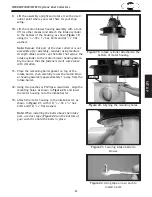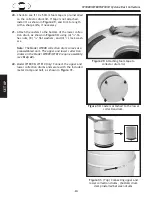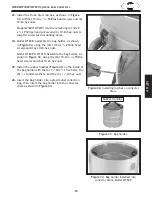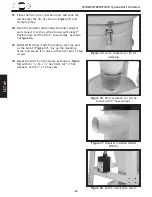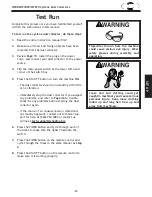
-34-
W1808/W1809/W1810 Cyclone Dust Collectors
O
PE
R
AT
IO
N
S
Calculating Duct Resistance
Adding duct work, elbows, branches and any other com-
ponents to a duct line increases airflow resistance (static
pressure loss). This resistance can be minimized by using
rigid (smooth) pipe and gradual curves, as opposed to
flexible pipe and 90˚ elbows.
To help you think about this resistance, imagine riding a
bicycle in a tunnel that is an exact replica of your duct
work. If the inside of the tunnel is very bumpy (flex-
ible pipe) and has a lot of sharp turns (90˚ elbows), it
will take a lot more effort to travel from one end to the
other.
The purpose of calculating the resistance is to determine
if it is low enough from the machine to the dust collector
to meet the given CFM requirement for the machine. Use
the charts in
Figure 52
to calculate the resistance of duct
work.
In most small/medium shops it is only necessary to calcu-
late the line with the longest duct length or the most fit-
tings (operating under the assumption that if the line with
the highest resistance works, the others will be fine).
To calculate the static pressure of any given line in the
system, do these steps:
1.
Make a list of each size duct in the line, including
the length, and multiply those numbers by the static
pressure value given in
Figure 52
.
2.
List each type of elbow or branch and multiply the
quantity (if more than one) by the static pressure
loss given in
Figure 52
.
3.
Add the additional factors from
Figure 53
to your
list.
Duct
Dia.
Approximate
Static Pressure
Loss Per Foot of
Rigid Pipe
Approximate
Static Pressure
Loss Per Foot
of Flex Pipe
Main
Lines
at 3500
FPM
Branch
Lines
at
4000
FPM
Main
Lines
at
3500
FPM
Branch
Lines
at 4000
FPM
2"
.091
.122
.35
.453
2.5"
.08
.107
.306
.397
3"
.071
.094
.271
.352
4"
.057
.075
.215
.28
5"
.046
.059
.172
.225
6"
.037
.047
.136
.18
7"
.029
.036
.106
.141
8"
.023
.027
.08
.108
9"
.017
.019
.057
.079
Fitting
Dia.
90˚
Elbow
45˚
Elbow
45˚
Wye(Y)
90˚
Wye(Y)
3"
.47
.235
.282
.188
4"
.45
.225
.375
.225
5"
.531
.266
.354
.236
6"
.564
.282
.329
.235
7"
.468
.234
.324
.216
8"
.405
.203
.297
.189
Figure 52.
Static pressure loss charts.
Additional Factors
Static Pressure
Seasoned (well used)
Dust Collection Filter
1"
Entry Loss at Large
Machine Hood
2"
Figure 53.
Additional factors affecting
static pressure.
Summary of Contents for SHOP FOX W1808
Page 2: ... ...
Page 5: ... 3 W1808 W1809 W1810 Cyclone Dust Collectors INTRODUCTION ...
Page 6: ... 4 W1808 W1809 W1810 Cyclone Dust Collectors INTRODUCTION ...
Page 7: ... 5 W1808 W1809 W1810 Cyclone Dust Collectors INTRODUCTION ...
Page 8: ... 6 W1808 W1809 W1810 Cyclone Dust Collectors INTRODUCTION ...
Page 9: ... 7 W1808 W1809 W1810 Cyclone Dust Collectors INTRODUCTION ...
Page 10: ... 8 W1808 W1809 W1810 Cyclone Dust Collectors INTRODUCTION ...
Page 50: ... 48 W1808 W1809 W1810 Cyclone Dust Collectors PARTS PARTS W1808 Parts Breakdown ...
Page 53: ... 51 W1808 W1809 W1810 Cyclone Dust Collectors PARTS W1809 Parts Breakdown ...
Page 56: ... 54 W1808 W1809 W1810 Cyclone Dust Collectors PARTS W1810 Parts Breakdown ...
Page 63: ......
Page 64: ......


